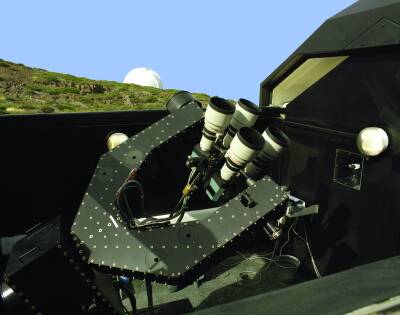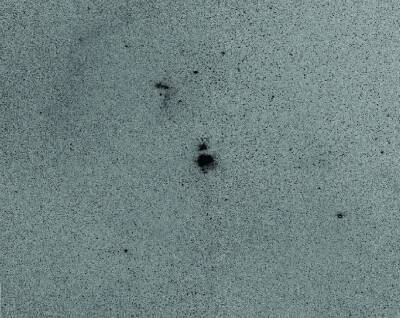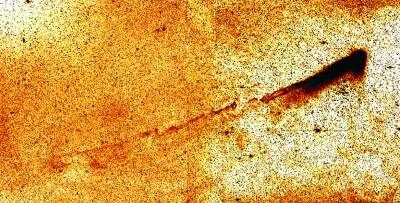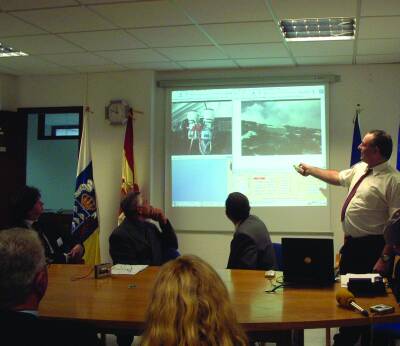 | |||
|
| Home > Public Information > ING Newsletter > No. 8, September 2004 > SuperWASP: The Trials and Tribulations of a Remote Inauguration Ceremony |
|
|
SCIENCE |
|
|
|
Previous: Cute-SCIDAR: An Automatically Controlled SCIDAR Instrument for the JKT | Up: Table of Contents | Next: WHT Auto-guider/TV Upgrades
Article mirrored at: La Palma server | Cambridge server
Other available formats: PDF
Don Pollacco* (Queen’s University Belfast), Ian Skillen (ING), Javier Méndez (ING) and the WASP Consortium
It is ironic that in this technical age we live in there are few professional facilities in operation that are designed to monitor the sky at optical wavelengths. Historically, this work has been left to dedicated amateur astronomers often using observatory grade equipment. Part of the reason for the absence of professional projects is the lack of reliable equipment and the huge data rates involved. The SuperWASP facility is an attempt by professionals to join in the exploitation of the time domain. It is the rapid development of robotic technology and affordable, but powerful, computing that has made this project feasible.
The main science aims of SuperWASP include the detection of extra-solar planets (the so-called hot-Jupiters), optical counterparts to Gamma-Ray Bursters and rapidly moving near-Earth asteroids. While the UK Particle Physics and Astronomy Research Council (PPARC) provided some seed funding for SuperWASP, the bulk of the funding came from the Queen’s University Belfast (QUB). Other contributions came from the Open University, the Royal Society, Andor Technology and St. Andrews University. The QUB funding became available in March 2002.
Those of you who have been out to La Palma over the last year may have noticed the appearance of the SuperWASP enclosure on the Roque. In fact avid viewers of the CONCAM all-sky images noticed that the building was erected during the day of the 6th July 2003. Shaped like a garage sized shoe box but with a peculiar stepped-roof, it is sited on the hillside below the JKT towards the Swedish Solar Telescope. The enclosure is composed of two rooms with the instrument itself located at the southern end of the building and the control computers at the other end. During normal operations the roof above the instrument slides, under hydraulic pressure, onto the computer room end, and the cameras are exposed to the sky. The SuperWASP cameras are contained within a cradle and mounted in place of a telescope tube in an equatorial fork mount.

|
| Figure 1. SuperWASP at dusk on the 27th November 2003 —first light. The WHT dome is in the background (photo courtesy Jens Moser). [ JPEG | TIFF ] |
Compared to, for example the INT Wide Field Camera, the field of view of SuperWASP is truly awesome: currently about 1200 times larger. To achieve this SuperWASP is composed of five cameras each having a dedicated telephoto lens and CCD detector. The lenses image onto the detector at low angular resolution (14 arc seconds per pixel) hence allowing a large field of view for the camera. This design allows us to achieve accurate photometry on bright objects (<1% for stars brighter than magnitude 13 for a single 30 second integration). However, with such large angular pixels the sky level is quite bright which limits the magnitude of objects detected (3σ detection at magnitude 16.5 per 30 second integration). SuperWASP is able to accurately measure the brightness of millions of stars in a single night.
The equatorial mount, along with the observatory control software, TALON, is the heart of SuperWASP. TALON controls all observatory functions (e.g. monitoring the weather station, GPS time service, etc.), as well as indirectly controlling all CCD cameras via their data acquisition computers. The computer room is protected by a telecommunications grade air conditioning plant. The detectors themselves are the 2048×2048 pixel e2v42 CCD devices familiar to WHT users, but are thermo-electrically cooled. The optics are the now obsolete Canon 200mm F1.8 telephoto lenses, often described as “the fastest telephoto lens available”.
After obtaining planning permission on La Palma, construction of the facility began in June 2003. In July, we erected the enclosure using probably the most highly qualified labourers available (and the worst paid!) followed by the associated electrical and communications work. By mid-August we installed the fork mount and built up the computer systems. By September 2003 we had completed the first pointing models with the mount and started to build up the camera cradle —initially with 4 detectors included. Engineering first light occurred late in the month. After a break for engineering work (and to give a lecture course) true astronomical first light occurred in late November 2003 —some 21 months after the funding became available. SuperWASP then regularly obtained data up until Christmas. We had a scheduled break for three months to address some of the many technical issues highlighted from our operational month, as well as to re-engineer some of the camera heads. The data from that period has proved invaluable in debugging the reduction pipeline prior to commencement of normal operations scheduled for mid-April 2004.

|
| Figure 2. First light mosaic image of the southern part of Orion. In this 1 second exposure the horse head nebula and Barnard loop are clearly visible along with some 35,000 stars. [ JPEG | TIFF ] |

|
| Figure 3. A two chip mosaic of Comet Neat on 15th May 2004 (courtesy of Alan Fitzsimmons). Wow! [ JPEG | TIFF ] |
As is common with new instruments we decided to hold an inauguration ceremony for the facility and it seemed like a good idea to hold this event at the start of operations on Friday 16th April 2004. However, as the date approached and with the detectors stuck with DHL in Madrid for several weeks (they arrived there a few days after the tragic terrorist attacks), we became more concerned that we may be forced to inaugurate the facility with just the single detector left on La Palma. Just to compound our problems, the weather on the Roque had been somewhat unpredictable with a severe cold spell. After several interventions on our behalf by various bodies, the detectors finally arrived back on the Roque on Monday 12th April, whereupon we built up the camera cradle. By Wednesday the weather had turned worse with a blizzard laying some 10 cm of snow overnight. At 3 pm the day before the inauguration was due to take place we took the decision to abandon the event at the summit, and after some discussion, to hold the event at the ING sea-level base. The IAC representatives rearranged the press and other official matters, and at the same time we rearranged the social activities.
Tests Thursday morning had shown that, in principle, provided the network traffic wasn’t too high, we could run SuperWASP remotely from sea level. Thursday afternoon we reconfigured the observing system to include streaming video from our internal network camera as well as a view of the building from our external camera. SuperWASP had always been designed to be able to be run in this way, but the weather conditions had forced us to attempt this operational mode several months before we expected to. We were surprised it worked so well! For the inauguration we would attach a red ribbon to the camera cradle which would (in principle) fall to the ground as the instrument was moved. At this time our UK based guests were also arriving, including Professor Kenny Bell (Pro-Vice-Chancellor at QUB) and Professor Martin Ward (Chair of the PPARC Science Committee).
Surprisingly the weather on the Roque on the day of the inauguration ceremony stayed fair but cold. With the remnants of the snow still around and some ice still on the road we felt vindicated in our decision to move to sea level. The event itself went almost exactly to plan, culminating with the Mayor of Garafía moving the cameras and the ribbon falling. This was just as well: there was no reserve plan, no pre-recorded videos of the instrument running. The only slight (well amusing) flaw occurred when after the ceremony the TV cameras asked to repeat the final part of the ceremony during which the ribbon stubbornly refused to fall until discreetly helped! Ironically the weather had forced us to remotely inaugurate a robotic instrument —a first as far as we are aware, and most satisfying given the adverse conditions we faced at the time.

|
| Figure 4. A moment of the remote inauguration ceremony of SuperWASP on 16th April 2004 from ING’s sea-level office in Santa Cruz de La Palma. [ JPEG | TIFF ] |
SuperWASP has now moved into the operational phase. At the time of writing the facility is running automatically but not yet robotically. During normal observing SuperWASP takes 30 second integrations which after allowing for readout and telescope movements results in, on average, about one integration every 60 seconds (for each camera). Each detector produces an image of 8.3 MB in size, hence an average night with the current system results in about 25–30 GB of science and calibration data. At the end of the night this is written to DLT tape and shipped back to QUB for analysis. After reduction the brightness measurements are stored in a database hosted (and funded) by Leicester University (LEDAS). We are currently gaining valuable information on how to run this instrument efficiently with a view to running a limited (attended) robotic mode in late 2004.
New funding, obtained by Keele and St. Andrews Universities, will allow the full expansion of SuperWASP (8 camera units giving a field of view of some 500 square degrees), as well as the construction of a clone facility destined for SAAO. In this configuration SuperWASP will be able to image the available part of the celestial sphere in only 67 pointings (with these optics), while the visible sky can be surveyed in less than 40 minutes. Thus SuperWASP can efficiently monitor the whole sky. Do not be deceived: it may be small but it’s powerful!
The WASP Consortium is composed of astronomers from the UK Universities of Belfast, Cambridge, Keele, Leicester, Open, St. Andrews as well as the IAC and ING. We are indebted and grateful to the staff of both the IAC and ING for their enthusiasm and support for this project, and look forward to a fruitful collaboration in the months and years ahead. ¤
*Email contact: Don Pollacco (D.Pollacco@qub.ac.uk)
| Top | Back |
|

